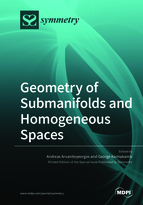Geometry of Submanifolds and Homogeneous Spaces
A special issue of Symmetry (ISSN 2073-8994). This special issue belongs to the section "Mathematics".
Deadline for manuscript submissions: closed (30 September 2019) | Viewed by 22875
Special Issue Editors
Interests: differential geometry; Lie groups; Einstein metrics; submanifold theory
Special Issue Information
Dear Colleagues,
The present Special Issue of Symmetry is devoted into two important areas of global Riemannian geometry, namely submanifold theory and the geometry of Lie groups and homogeneous spaces. Submanifold theory originated from the classical geometry of curves and surfaces. Homogeneous spaces are manifolds that admit a transitive Lie group action, historically related to F. Klein's Erlangen Program and S. Lie's inception to use continuous symmetries in studying differential equations.
In this Special Issue, we hope to provide a collection of papers that not only reflect some of the latest advancements in both areas, but also highlight relations between them and the use of common techniques. Applications to other areas of mathematics will also be considered. Submitted manuscripts should meet high standards of exposition and mathematical precision.
Prof. Andreas Arvanitoyeorgos
Prof. George Kaimakamis
Guest Editors
Manuscript Submission Information
Manuscripts should be submitted online at www.mdpi.com by registering and logging in to this website. Once you are registered, click here to go to the submission form. Manuscripts can be submitted until the deadline. All submissions that pass pre-check are peer-reviewed. Accepted papers will be published continuously in the journal (as soon as accepted) and will be listed together on the special issue website. Research articles, review articles as well as short communications are invited. For planned papers, a title and short abstract (about 100 words) can be sent to the Editorial Office for announcement on this website.
Submitted manuscripts should not have been published previously, nor be under consideration for publication elsewhere (except conference proceedings papers). All manuscripts are thoroughly refereed through a single-blind peer-review process. A guide for authors and other relevant information for submission of manuscripts is available on the Instructions for Authors page. Symmetry is an international peer-reviewed open access monthly journal published by MDPI.
Please visit the Instructions for Authors page before submitting a manuscript. The Article Processing Charge (APC) for publication in this open access journal is 2400 CHF (Swiss Francs). Submitted papers should be well formatted and use good English. Authors may use MDPI's English editing service prior to publication or during author revisions.
Keywords
- global submanifolds
- global surface theory
- Lorentz metrics, indefinite metrics
- immersions
- Lie groups
- homogeneous manifolds
- G-structures
- geodesics
- special Riemannian manifolds
- Hermitian and Kählerian manifolds
- Grassmannians, Schubert varieties, flag manifolds
- twistor methods
- statistical manifolds







